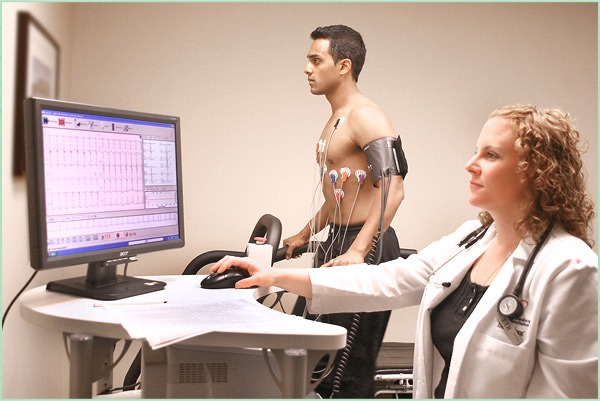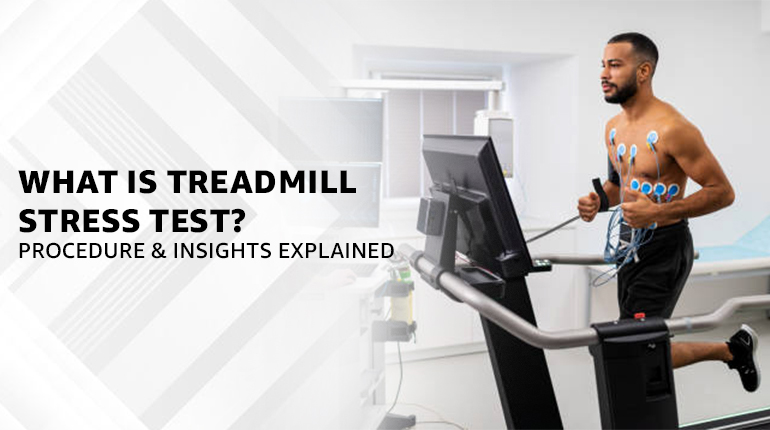In modern medicine, diagnostic methods have advanced greatly, enabling medical experts to gain valuable insights into a patient’s heart health. One such diagnostic tool is the Treadmill Test. It is commonly referred to as the TMT or Exercise Stress Test. This test provides important details about a person’s heart health by observing how it responds to exercise. This comprehensive guide delves into the Treadmill Test, outlining its procedure, associated risks, and the insights it provides through its results.
Understanding the Treadmill Test :
The Treadmill Test, also referred to as an Exercise Stress Test, is a medical procedure intended to understand how the heart reacts to exercise. In this procedure, a patient walks on a treadmill while medical professionals closely watch their heart rate, blood pressure, and ECG patterns. The goal is to mimic the stress the heart encounters during physical activity. It helps unveil any hidden irregularities that might not show up while at rest. This mirrors the heart’s exercise-related stress, exposing potential issues not visible at rest.
A Breakdown of the Procedure:
Preparation:
Before the test, patients are usually asked not to eat, drink, or smoke for a certain time. They may also need to avoid certain medications that could affect the test’s accuracy. A baseline ECG and blood pressure reading are obtained while the patient is at rest.
Equipment Setup:
Next, the patient is connected to an ECG machine using adhesive electrodes placed on the chest. These electrodes record the heart’s electrical activity throughout the test. A blood pressure cuff is also attached to the patient’s arm to monitor blood pressure fluctuations.
Gradual Intensity Increase:
The patient begins walking on the treadmill at a slow pace. By adjusting the treadmill’s speed and incline, the intensity is gradually escalated.
Monitoring:
Throughout the test, medical professionals closely monitor the patient’s heart rate, blood pressure, ECG, and any symptoms experienced. The ECG displays any abnormal heart rhythms or changes in the heart’s electrical pattern.
Assessing Symptoms:
Patients are encouraged to communicate any symptoms they encounter during the test, such as chest discomfort, shortness of breath, dizziness, or fatigue. This information is crucial in evaluating the heart’s response to stress.
Test Conclusion:
Ultimately, the test concludes when the patient reaches their maximum level of exertion or if they experience intense symptoms. Additionally, the healthcare provider might stop the test if they believe it would be unsafe to continue with further testing.
Interpreting Treadmill Stress Test Results
The Treadmill Test results are assessed based on various factors. They include heart rate response, blood pressure changes, and any ECG abnormalities. Here are a few possible outcomes:
1. Normal Response:

A normal result indicates that the heart functions well during exercise. There are no noticeable shifts in the ECG pattern, indicating the heart’s electrical rhythm remains consistent. Blood pressure remains steady, demonstrating the heart’s ability to manage the body’s increased demands. Moreover, the heart rate increases in a suitable manner, demonstrating the heart’s ability to handle the effort.
2. Positive Test:
A positive outcome could indicate a potential heart issue. This could be indicated by changes in the ECG pattern. There could be chest discomfort, abnormal blood pressure response, or other symptoms during the test. Besides, a positive result alone doesn’t conclusively diagnose a heart issue. Generally, more tests are required to gain a clear understanding of the situation.
3. Inconclusive Test:
At times, test outcomes might not provide a clear answer. This could be due to technical problems or a lack of enough data. Then, the healthcare provider could suggest doing the test again or trying a different diagnostic approach.
4. False-Negative:
Occasionally, a person with heart disease might have a normal Treadmill Test result, leading to a false-negative outcome. This can happen if the disease isn’t severe enough to cause noticeable changes during the test. Besides, it could also be due to if the test itself doesn’t accurately reflect the person’s heart condition. This emphasizes the need to factor in various elements.
Risks and Precautions to understand before a Treadmill Stress Test
While the Treadmill Test is generally safe, there are specific risks and precautions to consider:
Cardiac Events:
In rare cases, the stress imposed on the heart during the test might trigger cardiac events like a heart attack or arrhythmias (heart rhythm irregularities). Nevertheless, medical professionals and equipment are available to manage such situations promptly.
Physical Strain during the Treadmill Stress Test:
The test can be physically demanding, especially for individuals not accustomed to consistent exercise. Patients should inform their healthcare provider of any existing health conditions before undergoing the test. This helps the medical team adjust the test correctly and keep the patient safe during the procedure.
Symptoms:
As the test is designed to stress the heart, it might cause some discomfort. The patient could experience symptoms like chest pain, fatigue, or shortness of breath. It’s vital to tell the medical team about these symptoms. They can address them quickly and ensure safety and accurate results.
Equipment Malfunction:
While not common, there is a possibility of technical issues arising in the monitoring equipment. These malfunctions could potentially affect the accuracy of the test results.
In Conclusion
The Treadmill Test, also known as TMT, is a valuable diagnostic tool used to assess cardiovascular health and understand how the heart responds to stress. It plays a crucial role in helping healthcare professionals make informed decisions about a person’s heart health.
Through vigilant monitoring of heart rate, blood pressure, and ECG during exercise, medical professionals gain insights into potential heart-related issues. Ensuring the safety of the test is of the greatest importance. It’s vital to inform the medical team about existing health conditions and symptoms. The results of the TMT provide a foundation for further assessment. If necessary, these results help decide on potential treatments.
With the progress of medical technology, the Treadmill Test retains its significance in cardiology. This test remains a fundamental element that adds to our knowledge and care of the crucial organ, the heart. Its importance endures in the realm of cardiac care. As we move forward, the Treadmill Test remains integral to advancing heart health knowledge.
Read Also: Treadmill Checklist: 10 Points to Consider Before You Buy Treadmill

